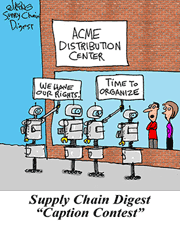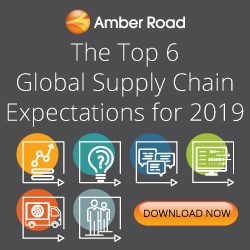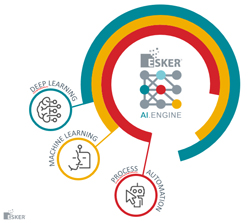Another View of the Best Supply Chains 2019
Last summer, I summarized both the results and the methods used by Gartner to compile its Top 25 Supply Chain list for 2018, right after it was published. Gartner has added on to an approach first started by the former AMR Research in 2004, after Gartner acquired AMR in 2009.
The top 25 list of course is of much interest, and companies that make it naturally tout that honor. As I noted in my column, I occasionally get calls from companies looking for advice on how to make the top 25.
Let me first say that I do not have a better way to compile a top supply chain list than the way Gartner does it. Only limited information is available for analysis - no one is sharing cost information, as just one example.
| GILMORE SAYS: |
Target (which may or may not have been one of the companies that has called me in the past about getting in the Gartner list) gets some justice in the Kantar rankings.
WHAT DO YOU SAY?
Send us your
Feedback here
|
That said, there are a number of criticisms that I think can be fairly leveled at the process. Those include:
Only large companies of $12 billion or greater revenue are considered.
The way the financial metrics are used does not necessarily connect with supply chain excellence. Does Apple's huge revenue growth (until recently) really stem primarily from supply chain excellence? Should McDonald's benefit in the rankings because its business model with outsourced food service providers and daily deliveries give it a huge number of inventory turns versus most companies? Even the return on assets metric gives advantage to companies that have outsourced their supply chains and thus have a lower assets bases. But that strategy doesn't necessarily deliver a superior supply chain.
Even the so-called peer rankings, under which some 184 persons (I assume Gartner clients) rank the top supply chains (well not really the best supply chains, but those that are tops in "demand driven value network orchestration," a rather unclear criterion) is a bit suspect. How does anyone really know whether say chemical maker BASF (which made the top 25) has a better supply chain than say Target stores (which did not)? Is the ranking based on just public perception, vested interests in the outcome, something else?
The same observation could be made for the 42 Gartner analysts that performed a similar ranking. I think many of these analysts have a broader view of supply chain activities than the average peer group participant, but no one really knows how to rank performance across 300 supply chain candidates.
Finally, 10% of the Gartner total formula is now comprised of a corporate social responsibility (CSR) score obtained from third party sources. CSR may be a good thing, but certainly many aspects of these CSR scores are disconnected from what we normally think of as supply chain performance.
I think these are all fair critiques, yet I understand Gartner's position in terms of a lack of other data and and no obvious way to address these questions.
Well, there is actually is another way. That is to directly ask companies that should be in the know about the supply chain performance of other companies their perceptions, as they have on-going experience as trading partners.
That is the approach that Kantar Retail (now Kantar Consulting) has been taking for many years in its annual PoweRankings report, the latest of which was delivered in late 2018.
The full study covers a number of company performance measures for both consumer goods manufacturers and retailers, including such areas as brand power, marketing programs, sales teams, overall business fundamentals, and more. Supply chain management is one of the categories included in the survey.
The rankings for last year, as always, were developed through the interesting methodology of asking retailers to rate manufacturers on each of these categories, and manufacturers to rank retailers on a similar set of attributes. Most major CPG companies and retailers take part, with about 80 participant companies in each group.
Both manufacturers and retailers are from the consumer packaged goods, food and beverage areas. That means manufacturers in such categories as apparel/soft goods, electronics, hard goods, etc., are not included. Similarly, the participating retailers are drawn exclusively from sectors such as mass merchandise, traditional grocery, warehouse clubs, and drug store chains that focus on consumer packaged goods sales, and does not for example include department stores or most specialty retail areas. For the last few years, however, Amazon.com has been included in the retail group.
The scores represent the percentage of respondents that place a given manufacturer or retailer as having one of the top three supply chains in the industry.
So the analysis pool is limited to CPG type companies and their retail channel partners. That said, below are the top rated consumer goods supply chains for 2018:
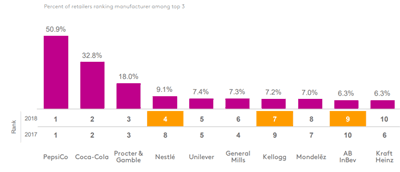
See Full Image
Just to be clear, the results says that 50.9% of retailers placed PepsiCo as having one of the top three CPG supply chains, as did 32.8% of retailers for number 2 Coca-Cola, etc.
Interesting, as always - and naturally leading me to wonder how these results compare to the Gartner Top 25.
The top rated overall supply chain across all companies by Gartner was CPG manufacturer Unilever. It was number 5 in the Kantar rankings of just CPG companies. Colgate-Palmolive was the number 4 ranked supply chain overall and second highest CPG company in Gartner - but alas Colgate does not even make the Kantar top 10 list of just CPG manufacturer supply chains, as rated by their retail customers. There are other such discrepancies.
A somewhat similar story on the retail side, though the comparisons are more difficult:
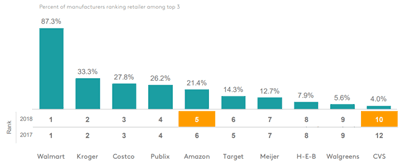
See Full Image
Amazon has been placed in the Gartner "supply chain masters" category for consistent appearance in the top 5 of the rankings, and thus was not included in the actual top 25 for 2018. But in the Kantar rankings, based on CPG company ratings, Amazon is number 6, behind Walmart, Kroger, Costo, and Publix and now ahead of number 6 Target.
Of those five retail companies (top six minus Amazon), only Walmart made the Gartner top 25. Target (which may or may not have been one of the companies that has called me in the past about getting in the Gartner list) gets some justice in the Kantar rankings, in my opinion. It could be the retailers don't make the top 25 due to lower profit margins that the manufacturers, and have a tougher time driving growth through acquisitions.
How to reconcile these differences? Don't know. The methodologies are totally different, so different results should be expected. But ratings from counterparts at trading partners seems about as good an input that you can get to gauge supply chain excellence.
What is your reaction to these comparisons between the Gartner and Kantar lists? How would you improve the Gartner approach? Let us know your thought at the Feedback button below.
|



![]()

![]()

![]()


